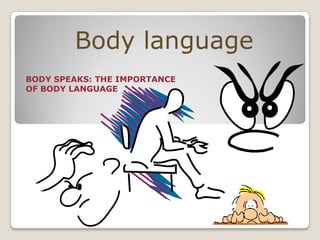
Body Language Signals More Than Words
- 1. Body language BODY SPEAKS: THE IMPORTANCE OF BODY LANGUAGE
- 2. DEFINITION Silent (non-verbal) messages communicated through the sender's body movements, facial expressions, voice toneand loudness, etc. In social psychology, all behavior in presence of another person is considered communication. Also called kinesis communications. See also non verbal communication Up to 93 % of communication is non- verbal. Including tone of voice, eye movement, posture, hand gestures, facial expressions and more. The pressure of body language can especially be felt in emotional situations. Body language usually prevails over words.
- 3. Types of nonverbal communication and body language There are many different types of nonverbal communication. Together, the following nonverbal signals and cues communicate your interest and investment in others.
- 5. Facial expressions The human face is extremely expressive, able to express countless emotions without saying a word. And unlike some forms of nonverbal communication, facial expressions are universal. The facial expressions for happiness, sadness, anger, surprise, fear, and disgust are the same across cultures.
- 6. Body movements and posture Consider how your perceptions of people are affected by the way they sit, walk, stand up, or hold their head. The way you move and carry yourself communicates a wealth of information to the world. This type of nonverbal communication includes your posture, bearing, stance, and subtle movements.
- 7. Gestures Gestures are woven into the fabric of our daily lives. We wave, point, beckon, and use our hands when we’re arguing or speaking animatedly—expressing ourselves with gestures often without thinking. However, the meaning of gestures can be very different across cultures and regions, so it’s important to be careful to avoid misinterpretation
- 8. Eye contact Since the visual sense is dominant for most people, eye contact is an especially important type of nonverbal communication. The way you look at someone can communicate many things, including interest, affection, hostility, or attraction. Eye contact is also important in maintaining the flow of conversation and for gauging the other person’s response
- 9. Touch We communicate a great deal through touch. Think about the messages given by the following: a firm handshake, a timid tap on the shoulder, a warm bear hug, a reassuring pat on the back, a patronizing pat on the head, or a controlling grip on your arm.
- 10. Space Have you ever felt uncomfortable during a conversation because the other person was standing too close and invading your space? We all have a need for physical space, although that need differs depending on the culture, the situation, and the closeness of the relationship. You can use physical space to communicate many different nonverbal messages, including signals of intimacy, aggression, dominance, or affection.
- 11. Voice We communicate with our voices, even when we are not using words. Nonverbal speech sounds such as tone, pitch, volume, inflection, rhythm, and rate are important communication elements. When we speak, other people “read” our voices in addition to listening to our words. These nonverbal speech sounds provide subtle but powerful clues into our true feelings and what we really mean. Think about how tone of voice, for example, can indicate sarcasm, anger, affection, or confidence.
- 12. Examples of Body Language NONVERBAL BEHAVIOR INTERPRETATION Brisk, erect walk Confidence Standing with hands on hips Readiness, aggression Sitting with legs crossed, foot Boredom kicking slightly Sitting, legs apart Open, relaxed Arms crossed on chest Defensiveness
- 13. Walking with hands in pockets, Dejection shoulders hunched Hand to cheek Evaluation, thinking Touching, slightly rubbing nose Rejection, doubt, lying Rubbing the eye Doubt, disbelief Hands clasped behind back Anger, frustration, apprehension Locked ankles Apprehension Head resting in hand, eyes Boredom downcast Rubbing hands Anticipation Sitting with hands clasped behind Confidence, superiority head, legs crossed
- 14. Open palm Sincerity, openness, innocence Pinching bridge of nose, eyes closed Negative evaluation Tapping or drumming fingers Impatience Steepling fingers Authoritative Patting/fondling hair Lack of self-confidence; insecurity Tilted head Interest Stroking chin Trying to make a decision Looking down, face turned away Disbelief Biting nails Insecurity, nervousness Pulling or tugging at ear Indecision
- 15. CONCLUSION From the above slides we can conclude that body language really speaks a lot. We can feel it’s presence in day today life and is necessary to communicate things in an expressive way. Body language gives life to the persons communication and in this way the listener can understand the talks in a better way.
- 16. Lakshmi sharma